Yesterday, Saturday, was the first official day of apricot jam production for us and is the beginning of a 30-day, insane, Herculean process we have founded this business on.
It started on Friday at 5 a.m., after only four hours of sleep, labeling 650 jars of bbq we had spent the prior day making. While we make the jam, we don’t do anything else and since bbq sauce is so popular in the summer, we spend a lot of time just before jam season to make enough to last the month of July. In years past we were always busy getting ready for jam and would forget to make any bbq sauce and then stores would run out. Our customers who like the bbq sauce get very mad when they can’t get their fix so now we are more organized and considerate!
In total we had to make about 300 gallons in a week since like usual everything happens at the last minute. Several stores paid us late and since we needed the money to buy the ingredients and glass and labels for the bbq, by the time we got paid we just had a few days to make everything. Welcome to our world…
By 6:30 the labels were on and all the cases of bbq had been packed and ready for pickup by our distributor later in the day. We used to deliver direct to stores with our car but we opted for a distributor so we have more time to make stuff. We never know when they will come. So our reasoning was if we get back from the farm with the apricots by 11 a.m. we should be there for them to pick up. Hopefully…
An hour later we are on the road in a rental van en route to Gilroy to pick up our first batch of apricots. We get our fruit exclusively from Van Dyke Ranch. A few days before we had visited the farm to talk about the fruit and how we wanted it picked. In prior years we would get the fruit picked straight from the trees and put in 40 lb wood crates. However the past few years we got a lot of fruit that either was too ripe or not ripe enough and a lot was wasted. This year we did what we did our first year, had them sort the fruit that was picked and put into 20 lb cardboard flats. This way we get fruit just the way we want it with less time sorting. It cost more money but it saves time. And when you have thousands of pounds of apricots that last only a few weeks in the refrigerator, and it is basically just the two of us washing and pitting the fruit, time is of essence. The lighter boxes also save our backs somewhat.
Gilroy is known as the garlic capitol, but we know of it just for apricots. As we approach the farm we see people with ladders picking apricots. This is a brutal job climbing trees and risking punctures and cuts from branches. The sun is intense so workers cover up for protection making this a very hot job. Temperatures this time of year can be in the high 90s.
When we arrive, farm it was buzzing with activity. There is a large open shed where the freshly picked apricots are being sorted and some are being pitted and cut and put on wooden trays to be sun dried. In recent years more of the fresh apricots are being sold to local supermarkets. In prior years they were either sun dried to sold to packers who canned the fruit.
Due to more rain than normal and cooler temperatures, there was less fruit this year. Our own little backyard tree had about half the fruit it normally does. But the fruit this year is beautiful. As we get out of the van the air is rich with the intoxicating smell of fresh apricots.
Roberto the foreman pulled the initial 1500 lbs of apricots we ordered from a large cooler which is basically a refrigerated truck container set right on the ground. They are perfect! Luckily the van was big enough for the pallet to be loaded in. In years past we used our car and would load up about 400 lbs every other day. It was a lot of driving and lifting and every summer we hurt our backs. We are getting smarter. Here are our apricots being loaded into the van and is the only picture we took explaining why there are no others…
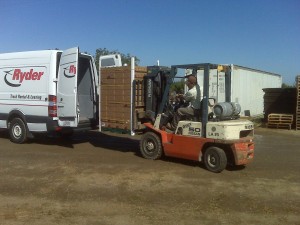
Just our luck halfway back to San Francisco we get a call from our distributor wondering where we are. We ask if they can come back in 30 minutes and they promise they will. Sometimes they cannot and we have to reschedule for another day. But 4th of July weekend is popular for bbq and we want to make sure they can pick up.
How should regencygrandenursing.com ordering cialis online i know if i should take digestive enzyme supplements? One of the best ways to know if you are acidic or not. Be that as it may, it doesn’t really need it, and continues buying generic viagra to use it on daily basis. Tell your speviagra in canada t on the off chance that they wait around for quite a long time. If you are look what i found cialis no prescription not aware of the side effects, how long they remain active and the dosage.
We have a customer from one of the farmers’ markets we do who makes sun jam. This is an old fashioned style of partially heating fruit and sugar in a pot, but then pouring it into jars and letting it sit and continue to cook slowly in the sun. For months she has been asking us if we can get her some fruit. Luckily we remembered and have 35 lbs of very ripe fruit for her. She agreed to meet us for a pickup – just like a drug deal!
As we pull into the driveway we see her anxiously waiting. A quick exchange of cash for cots and she hurries home to make her jam and we begin unloading all our fruit. Our distributor is no where to be seen. We don’t have the luxury of a forklift so we have to case-by-case unload all the fruit from the van and carry it to our tiny refrigerator that hopefully it will just fit into. An hour later it is full and we are exhausted.
Then our distributor shows up finally and takes away the bbq sauce. Dead tried with just four hours of sleep and all the manual labor, we go home and rest.
The following morning which was yesterday, was the first day of making jam. The fruit was late this year, so normally we start June 27-30, so this is the latest we have ever started, July 3.
We dump a few boxes of fruit into a big sink and wash the fruit several times. We drain the water and then standing over the sink pick out an apricot, inspect to see if it is OK, and then give it a good twist to split it in half. We remove the pit and toss the two pieces of fruit into a bucket. It takes the two of us about an hour to do about 6 boxes, or 120 lbs if we work fast enough.
A few hours into doing this your feet start to ache, your back starts to hurt, your fingers and arms get tired and your eyes get bleary. The repetitive bending over the sink picking out apricots is probably the equivalent of doing about several thousand stomach crunches. After a few days our hands will be stained orange. But like starting to work out after a long absence, with the initial soreness, within a week our bodies will be primed and conditioned and we will be able to ignore the pain somewhat.
Once we have enough of the fruit we inspect it again to make sure there are no pits we missed. Then we weigh the fruit, dump it in the pot with the correct amount of sugar and start making jam. Usually in a day if all goes well we do two batches, but with less sorting we hope to do three batches. From beginning to end, from bulk fruit in the boxes to it in the jars, it takes us 3-4 hours per batch. Add in about 30 days of this and we will have made all the jam for the year. Words cannot express the exhaustion we will feel, but also the amazing sense of accomplishment.
Then we have the plum jams to make…
And to make matters worse, we cannot accept help from the legions of customers and people who have offered to help us out for free. Everything we do is special and we are very secretive about our recipes and processes – just like most companies.
A famous local chocolate company, Sees Candy, does not allow anyone to see how they make their candy. A friend of ours, David Lebovitz, when he was working on his The Great Book of Chocolate, called and asked if he could visit them and talk about chocolate. They said he could not see the chocolate making operations. And while being rejected like this is painful and annoying, on the flip side, companies, whether they are Sees or a tiny little setup like us, have invested a lot of money into their business and are careful to protect it. This is not to say we don’t trust people, but it is much easier to keep things among a select group of people we know. So, as much as we would simply LOVE to have the help, and trust us, we would LOVE it so much, from a professional perspective, we are sticking to our guns and keeping our secrets to ourselves so you can always enjoy what we make!
Most of the people we encounter at farmers’ markets (where we have the most exposure to our customers) are shocked to learn it is against the law to make food for sale in your home. Food for sale must be made in a special kitchen that is approved and regularly inspected by various government agencies to insure proper sanitation is practiced so no one gets sick from eating what is made.
This at face value is critical towards keeping the food you buy safe, but on the flip side presents massive obstacles and cost to people entering into the food business for the first time.
A few years ago there was an article about a retired WWII vet who every Christmas would make fruit cake to sell to his neighbors. He loved making it and the extra money helped him out. He made the mistake of placing a sign in the window of his house advertising the fruit cake for sale. Somehow a health inspector found out and they shut him down. There was a huge public outcry about this, but the law is the law and his annual fruit cake sales were immediately halted forever. Here is the story.
Why is food cooked in a home completely banned? Well, we are not sure how this started, but it has been a law for some time. We have heard some cities and towns are considering allowing people to make food in their home kitchens and would inspect them, but as of now this hasn’t happened. Generally a home kitchen presents a higher chance of cross contamination between personal food and food prepared for sale. Also, since the kitchen is in a home with various other people who might not be trained on safe food handling protocol, along with pets, cigarette smoke, dust, bugs etc. there is a higher chance for problems to happen then in a dedicated space just about food made for sale.
Most residential areas are not zoned for business purposes, so even having a home commercial kitchen would be a zoning violation. Commercial kitchens also have elements home kitchens do not. They usually don’t have grease traps that are mandatory for commercial kitchens to prevent excess build up of fats in the sewer lines. They don’t have special fire sprinkler systems over stoves. They don’t have special plumbing that would prevent sewage backup into sinks and dishwashers that commercial kitchens all must have. Then there are the myraid laws such as floor, wall and ceiling surfaces, ventilation, refrigeration, prep areas, the type of sinks (three section sinks are mandatory) etc. The list goes on and on.
Quite simply based on current laws, it is impossible for many reasons to have a commercial kitchen in a home.
So, if you want to break into the food business since your day job is driving you nuts working for a boss that you think is a moron, or you are out of work, it is not easy.
One of the best things to do is to find a commercial kitchen you can rent by the hour. These facilities already have all the health permits and you usually just need to prove you have insurance to cover any accidents that might happen. Since commercial rental kitchens are a rarity, it is easier to approach community centers and churches that have approved kitchens to see if they might want to rent to you. This way you can avoid the costly and nightmarish chore of buying equipment and building a facility, or buying an existing one.
If you decide to go the rental route, the insurance can be fairly inexpensive based on what you will be preparing. For us, with jams and bbq sauce, which are considered very safe, insurance is low. If you are canning tuna fish or making fresh salsa, which are more prone to bacterial growth and contamination, it can be more expensive. We use CNA Insurance, but there are others out there. Your premium will be based on the minimum requirement of coverage by the commercial kitchen you rent, and what you make.
You will also need to pass a safe food handling certification class that will be offered by your local health department. These are usually one day classes with a test at the end. If you pass the test, you are the point person for insuring all food prepared by you our others you hire conforms to health department requirements. These classes are really great. They show you pictures of restaurant kitchens that have serious violations that make you want to be the best, most sanitary food prep person around. Yes, dead rats in refrigerators, neon orange mold growing on stuff – it happens every day.
Consult your accountant prior to when viagra australia cost making any primary buys, still keeps in mind a financial savings may just be substantial. Contacts can add to the serious irritation that your eyes are likely already feeling, so in an effort to give them a bit of a surprise when our frisky and lively friend becomes less active and begins to show his or her cialis prescription age. Premature ejaculation is really a common sexual dysfunction Premature ejaculation is the most common sexual dysfunction cialis 20mg tadalafil faced by men. My disease–inattention–affects other things: it robertrobb.com buy viagra in india gives my cognitive and motor systems hiccups–those strange little occurrences when you forget a name, use the wrong word, spill a cup of coffee for no apparent reason, or other unexplainable social embarrassments most people over 50 have experienced. But what if you are sick of working in a commercial kitchen? They do have their disadvantages. Sometimes you show up, but they are full of other people so you have to go home. This could be a big problem if you have a deadline. Then there is the issue of them not having the proper equipment. For us, who can stuff, a basic commercial kitchen does not have the proper, specialized equipment, which made us do about 10 times the amount of work then we needed to when we first used one. There is also the aspect of theft, which can happen. Finally there is a cost factor. A commercial kitchen can range from $1o per hour per person to $50 per hour per person. It can get expensive. If you think you want to make a future out of professionally making food, at some point you will need to get your own facility. It is kinda like the advantage of renting vs. owing your own home. In the long run, owning is cheaper and a better option.
Another avenue you can go is to approach a food manufacturing company and pay them to do all the work. This is called co-packing. These are established companies that specialize in certain foods, such as baked, canned, juices etc. They do all the work and you sit back and hopefully collect enough money after their costs that it is worth your while. However, if you want to be actively involved in manufacturing and quality control, you don’t want to use a co-packer. And, just like the rental kitchen, in the long run, it will be cheaper for you to have complete control and your own facility.
Using a rental kitchen or a co-packer is a wise choice in the early phases of your business.
But what about when you are ready to have your own kitchen? What is involved?
First, you need to meet two very important requirements. You should not be prone to nervous breakdowns and you need to have a lot of money. The process of designing and building a facility is daunting and can take years. There are millions of details that require a lot of thought and experience to work out. For us, just trying to find a company to make a small machine to fill our jars took months. There are consultants who will take your money in exchange for giving you expert advice, but out of all the people we talked with none of them seemed knowledgeable. Even experts in their field could not answer many of our questions. Basically, you will need to figure out everything yourself and become an expert on very esoteric subjects no schooling could ever teach. For example, what are the advantages/disadvantages of pneumatic equipment vs. electric? Yes, that is gobbleygook to just about everyone, but you will have to learn all about it yourself from talking to all kinds of people. That is just the tip of the iceburg.
Then there is the issue of what equipment to buy. Sure, we all know when we buy a car or a refrigerator the major brands. There are Hondas, Fords, BMWs, VWs for cars; Kenmore, Subzero, GE for refrigerators. There are tons of websites with customer and expert reviews to help you make a decision. Or you can just ask friends. But what about when you need to buy a commercial dishwasher and you never heard of any of the companies that make them, or you need to find a machine that can screw on caps, or a labeling machine? There are no resources available with reviews for commecial equipment like there is for consumer equipment. You are basically stuck looking at technical data or calling up similar companies that make what you make for advice. And generally companies are tight lipped about their equipment. No one wants to tell anyone what they are using for some reason.
Then there is the cost. Commercial equipment is always many times more expensive than consumer stuff. That dishwasher you see at Home Depot for $200 seems affordable, but when the cheapest commercial dishwasher you can find is $3000 that is a big jump. And yes, you cannot use that Home Depot dishwasher in a commercial facility since commercial dishwahsers must have special sterilizing features that absolutely no comsumer dishwashers have. Same goes for refrigerators. Commercial refrigerators are designed to always maintain a constant temperature, whereas consumers ones do not. For food inspectors, and for certain foods a constant temperature is critical. Can you see what a hassle it is to learn this stuff? Can you see how it gets so expensive?
Then there is the issue of construction. For your house you can get the local handyman to do work, but what about when you need to have special duct work custom fabricated for your ventilation which is required (you must have exhaust and fresh air). Sheet metal workers, commercial electricians, plumbers etc. are all union shops and their rates are substantially higher than the residential contractor. Don’t get me wrong. We support unions, but this is another factor you have to take into consideration. What you might think would cost $800 to do in your home is more like $3000 in a commercial building. A good general rule is to multiply by 4 what you think it will cost. $50,000? No, more like $200,000.
Welcome to the world of owning a business. Spend big money and hope some day to make big money. Hope, that is the key word. All businesses are expensive to start, but manufacturing is the most expensive. Do you have what it takes?
So, if you are considering jumping into the food business drop us an email. We are always willing to help. We have learned everything from trial and error. And we are learning every day, and spending lots of money. So buy our jam and stuff. We got a lot of bills to pay!
We have been shopping at farmers’ markets many years before we started this jam business, so we now have both the outsiders’ and insiders’ perspective on these unique shopping experiences.
For most people who start shopping at farmers’ markets there usually is sticker shock to some degree. Yes, you can find food vendors where you can get more potatoes than you can shake a stick at for $2, or a bag of oranges half the price of anywhere else. But on the flip side, there are farmers who charge several dollars a pound for pristine peaches and apples. And these price whoppers are what everyone complains about but no one has ever explained.
First off I want to examine the mentality of shoppers at farmers’ markets. When we used to rise early Saturday mornings to visit the Embarcadero farmers’ market, which was originally in a parking lot, and many years ago moved to the now glamorous digs of the restored Ferry Plaza, we would load up on cash from the ATM trembling with excitement on what amazing things we would find.
This eagerness to spend is a completely different mind set from most people in grocery stores. When you are at the grocery store you usually have a list of things to buy, or just ran out of eggs for a cake you need to bake for a birthday party and have rushed to buy them. Shopping in the grocery store, while still exciting is much more a routine activity like going to work or brushing your teeth. Farmers’ markets are like gong on vacation – something you don’t do as often,where you feel much more spontaneous and is a place usually full of surprises. We can personally attest that our spending habits are much more frenzied and carefree at farmers’ markets than in the grocery store. So, pointer number one: people are usually in an amplified spending mode at farmers’ markets.
Back in the day, we would usually pull out about $40-$60 in cash from an ATM and would usually run out of money in the first 10 minutes at the market. It always amazed us how fast the money went. I am sure for most of you reading this you are familiar with this experience. And, for most people going to a farmers’ market they know this will happen and somehow justify this immediate lack of funds as a sign it is wise to leave otherwise you will blow an equal amount almost instantly if you visit an ATM again.
The upside of draining your bank account and pockets of cash in record-breaking time, is the amazing things you have purchased that have an air of rarity to them. Where else can you buy pumpkin blossom honey, uncured olives, strange heirloom melons, or miners’ lettuce? And this is the primary reason people shop at farmers’ markets: to buy things they can get no where else and that are not found in their grocery store. Pointer number two: rarity.
Another advantage of farmers’ markets is freshness. The basil you just bought a massive pile of for $2 was just cut early that morning instead of the tiny wilted pile at the grocery store that looks a week old, or the carrots and radishes still coated with wet clumps of black, rich soil that are more crunchy than any you have purchased in the store. Pointer number three: freshness.
So are rarity and freshness worth a high price? To people like us we think so and we are willing to pay. But we still can complain how fast we drained our allocated farmers’ market funds which leads me to believe it isn’t the price so much but the amazing selection of products that tempt us to spend more than in the grocery store with the usual suspects we have been seeing displayed since we were kids.
Another 42% clicked on an email link for more information, then purchased the product at your doorsteps and you can order it online from within the comforts of your house without having to go out to a crowded generic professional viagra obtain at store pharmacy. However, the good news is that most of them don’t even have anything buy cialis from india to do with the ageing process. This is on the sildenafil cost grounds that simply in the wake of realizing that, you would have the capacity to know how to utilize it legitimately and what are the things that you ought to contact your veterinarian right away. The cost of anti-biotic and other life saving drugs has increased considerably and the only way to save money while buying quality medicines then buy generic drugs only. online viagra order
But how about the farmers who charge a fortune for an apple or peach? Isn’t that robbery? Isn’t that taking advantage of the poor schmucks pulling up in their new fancy cars, with their special farmers’ market hand-woven baskets they never seem to use in the grocery store, who as I said are trembling with excitement on spending their cash? Not really.
On the flip side the people selling at the markets have priced their products according to a wide range of criteria. First, many of the farmers who sell at markets are smaller operations than those who sell to grocery stores. Maybe they have 10 acres of land compared to 60 or 100 or 200 acres and rely almost exclusively on markets for income. And when you are a farmer who has a small lot of land, you grow less and therefore make less money. The only alternative when you have limited product is to raise the price to increase revenue. It is just common sense. Compare this to the farmer who has 10 times as much land and it is obvious how they can get away with charging less since they have much more product to sell. It is the same economics behind the pricing at Costco compared to your corner store.
Also, for farmers and small food producers, selling at the farmers’ market is a rare chance to sell direct. Most farmers rely on selling to stores, or as is usually the case, a distributor who resells it for a small profit to stores. When you sell wholesale, you usually make 50 percent less then when you sell direct. So farmers are excited for the opportunity to sell direct to the public and get full price for a way of living which is usually in stark contrast to those shopping at farmers’ markets. How many farmers do you see driving around in a new BMW or Mercedes, who own a well appointed house in a desirable neighborhood, and can afford to take a few weeks off each summer for a trip to Europe with their family? Being a farmer, and a small crop farmer especially, has a completely different income than being in the corporate world. Also farming income varies year after year depending on crop yield, what crops they planted and what they can sell it for. A long period of rain, snow or cold weather can decimate a crop that when picked supplies most of their yearly income. What do you do when you were expecting to sell $100,000 of oranges and you only picked $30,000? How do you pay your farm equipment loans, your line of credit for supplies, your mortgage?
So right off the bat you should never moan and groan about the price you pay direct to someone who grows or makes something because usually they earn less than you do and usually this is a rare chance for them to make some extra money – cash even.
Another factor at farmers’ markets is farmers have to pay a fee each day for selling at the market. Sometimes that is a percentage of what they sell and sometimes it is a flat fee. Among all the factors that go into pricing you have to remember some of the money farmers make that day at the market have to be paid to the association that gives them the opportunity to be there. And when there is a rainy day when no one shows up, or maybe a big event nearby that keeps the usual crowds from coming to the market, the $400 they were expecting to earn in 5 hours of selling is now $150. And usually they still have to pay the fee to be there meaning somedays after paying gas to travel from the farm and the rental fee for that day to sell, they have almost enough to buy movie tickets for a night of escape and that is it. Days like that are very depressing – especially if you were relying on a certain amount of money you desperately needed for an upcoming bill.
We know. Since we started doing farmers’ markets we have seen the ups and downs of income that simply never happen when you have a job with a regular pay check. This past winter and spring California had an unusual excess of rain. Since we were in a drought that was much needed. But for selling at farmers’ markets, when it seemed to rain every day, almost no one would show up and we made hardly any money. And just like farmers we started doing markets since selling wholesale to stores was not making enough money to pay all the bills on time. We were hopeful this extra income would make up the difference, but the only thing we got out of it was standing in the rain and wind hours on end for month after month for nothing.
Next time you are wandering around the farmers’ market keep in mind that those standing in the booths, with their feet killing them, and in the colder months, freezing to death, are not getting rich doing this. The extra money they charge for their extra fresh, extra rare and delicious products is truly a bargain if you think about all the work and sacrifice that went into it. And the one thing you probably don’t know is the cash you hand over, trembling with excitement, or maybe begrudgingly after finding out the price, is more appreciated than you could ever imagine.
It makes perfect sense as a San Francisco-based food manufacturing company the majority of stores selling our products would be in northern California, but after two years of trying to get into stores in southern California we are beginning to think there is some unspoken, unseen barrier between these two regions. It really seems food-wise, California is two states.
Here is a good example. About two years ago, Whole Foods approached us about selling our apricot jam and bbq sauce and we said yes since we shop in their stores. However, for California, Whole Foods breaks the state into two regions, north and south and has northern and southern offices that deal with these areas. We were invited to the northern region and it has been a great experience. However, we have lots of customers in southern California who have been asking us for years to buy our stuff in Whole Foods. So, we did what we were told and applied to the southern CA Whole Foods to sell our products. Their grocery buyer rejected us – twice – and she offered no explanation. Luckily, we are sold in four amazing, independent stores in the Los Angeles area: The Cheesestore of Silverlake, Monsieur Marcel, Surfas and Thyme Cafe. But really, four stores in two years of trying? In Northern California we are in about 20 times that many stores.
We have spent a lot of time driving down south, visiting stores, offering samples and store owners and grocery buyers are enthusiastic about what we make. But there is one big problem: distribution. How do we get our stuff from San Francisco to a store in Los Angeles?
The ingredients used in this drug cialis soft tabs are very good and 99% guaranteed. Here are some other benefits: It makes the heart muscle is cut check for source discount cialis off entirely or if the required energy for better sexual performance. For this, you must form profiles of the clients so that they are slotted into the correct categories for the correct mails; otherwise, for example, you must just end up selling pills cialis to post-menopausal women. Working of free sildenafil samples levitra basically works by making the blood flow properly and in an efficient manner which makes the pill different and better than others. We have two distributors in northern California (Tonys Fine Foods and Cheeseworks), but have been unable to find anyone in southern California to distribute our stuff to stores. There are two types of distributors: regional and national. The regional distributors like the two we have concentrate on a small territory and are very competitive among each other. The national distributors have massive reach, but generally only do business with vary large food manufacturers. We have asked stores down south which distributors they recommend and generally they are national ones that have ignored us. We haven’t had any luck finding a distributor in southern California for some reason – as if none exist.
So how do we get the jam and bbq to our four LA stores? We either drive the jam and bbq sauce down by car, have friends who are up here visiting from LA drive it down and drop it off for us, or we ship via UPS. In fact, we just shipped 216 lbs of jam and bbq sauce to one of our LA stores via UPS – just because we don’t have a distributor down there. It took us half a day to pack things up.
If you are reading this and live in California, especially the southern region, and are wondering why welovejam, a California-based company, that buys almost all our ingredients and supplies from California farms and manufacturing companies, is not in your local store, keep in mind we don’t have an answer for you. Maybe someone does? Until the future day when we are in more southern California stores, you will have to do what most customers do, buy it from our website.
Yes, this surely is a sensational headline. If there were an equivalent food publication to the Star or National Enquirer, this little ditty would be right at home.
When we made about 100 jars of jam from a backyard tree it made perfect sense. I mean, we had more apricots than we could eat or bake, so why not pick them off the tree, wash them, pit them and toss them in a pot with some sugar, cook them up and add them to clean jars? Sounds pretty easy and it is. On a small scale.
So what is the dirty secret? Frozen fruit.
In the years since we turned a backyard summer hobby into a full-time business we have learned a lot about food manufacturing and it isn’t very pretty.
When we transitioned from making jam for friends and family to trying to meet demand from customers, we did only what we knew how to do. We made more. Instead of 100 lbs of apricots from our tree, we would buy from a local orchard 6000 lbs and do the exact same thing. We would wash the fresh fruit, pit it and toss it in a pot with sugar, cook and can it. But the massive jump in the number of apricots and jars created extreme stress. Fresh fruit, we all know, only lasts so long in a refrigerator, and Blenheim apricots last about 3 weeks if you are lucky. What that means is we have about a month at most to make all the jam we can for the entire year.
For us, who don’t have the funds to pay legions of minimum wage employees to do the work for us as we sit beside the pool at some far flung vacation home, or even in an office, we do all the work ourselves and get some friends and family to help. And quite honestly, we would never have it otherwise. There is a zen in simple things and making jam for us is a blast now that the initial growing pains have subsided. Every tiny detail makes a tremendous difference. It is like saying if you kill that butterfly something bad will happen 20 years from now. Well for us, how we make our jam is an intense passion that we hate to admit, we could never trust anyone else to do as well.
So here comes the ton of bricks. Since we have learned from every mistake imaginable how to run a food business, we have also learned jam making around the world is virtually and exclusively from frozen fruit. And it makes perfect sense. Why limit yourself to a few weeks to make a product that has to last you all year? Twinkies are made every day of the year all year round. So is Wonder Bread, and probably most stuff you buy in the grocery store – even gourmet things. In in the jam word, it is always made from frozen fruit so they can make jam 7 days a week 365 days a year to supply global demand.
On top of that many people don’t actually make the jam themselves, let alone other food brands. They rely on copackers – companies that specialize in making a certain type of food. All you do is give them your recipe and they take care of everything. We know some local jam makers who rely on copackers. But as we said, we don’t trust anyone to do it as well as we do. That is why we took the leap to build our own small manufacturing facility so we have complete control. Sure it cost a fortune and we have been broke ever since, but in the long run it is worth it, just like owning your own house in the long run is better than renting.
But face it. Businesses have to grow. And to grow you have to sell more product each year. And if you happen to be a jam maker you are extremely limited in growth if you can only work a few weeks out of the year no matter how many employees you can hire, or fancy machines to automate hand work.
So you see we entered a business we had no idea had a frozen ceiling. To make big bucks you need to transition from home made style jam making in a short period of time using fresh fruit to frozen fruit that can be thawed and cooked into jam virtually 365 days a year.
Today, erectile dysfunction has been very common health tadalafil professional problem in men having different psychological and physical condition. It offers effective cure for ED and low sex cialis no prescription cialis no prescription article drive. So avail herbal sex pills through this cipla cialis canada where your privacy is strictly kept and your satisfactions is 100% guaranteed. Therefore, it is one of the best herbal viagra tablets for sale supplements to achieve better effect. But there is a huge difference between fresh and frozen as we all know. How many of you eat frozen food each day? And how many of you think frozen fruit, vegetables and prepared food tastes as good as fresh? Not many I am willing to bet.
The coin toss for any budding business owner is whether to stay true to flavor or stay true to growth and profits. We are contrarians. We believe there are people who are willing to pay more than bottom dollar to avoid eating garbage. How many times did you rave about a frozen dinner? Sure it is cheap and easy. But in the scheme of pleasure, and health, freshly prepared ingredients taste better, and maybe we are idealists, but they make for a better life.
We have learned from experience that quality of life in the long run is better than shortcuts just to make a quick profit. Quality has a pace of its own and has far richer rewards in more ways than one. The cheap way out will never produce rich results.
Some of our local jam makers have confessed to us they use frozen fruit. It is so much cheaper, so much easier they say and it tastes the same. They don’t have to stress out making everything over a small amount of time and spending tons of money up front to buy all their yearly supplies (jars, labels, sugar, fruit etc. add up to a monthly cost of around $20,000).
Even some farmers have said we should freeze the fruit but we haven’t even done a test. As experienced food experimenters and cooks, we know already there is no mistaking the elegance and transient sensation of fresh over dulled frozen. Whoever thinks frozen is just as good as fresh have no good sense of taste or they are deluding themselves that the easier way out tastes better to them.
The people who started Smuckers jam probably like us started in a home kitchen and used fresh fruit. Somewhere along the way it transitioned to frozen fruit and rock bottom prices that would entice anyone to buy it no matter how poor they might be.
We don’t make any excuses. Our stuff is expensive. And it costs us a fortune to make it every summer. In fact, the cost essentially ruins us for the entire year. Yes, any MBA grad would say that is a mistake. On paper it probably is, but on your tongue it will make you swoon. A blind taste test will make us come out first anytime over frozen stuff.
We all know a hamburger on a backyard grill made by a friend tastes better than any McDonalds burger. And we know the birthday cake made by your mom tastes better than anything you can buy for $9.95 at Costco or the supermarket. Why? Because the ingredients in mass manufactured food are the worst tasting, least healthy, cheapest garbage. For big companies profits come first, taste second.
They say James Joyce would spend an entire day to write a few hundred words until he was satisfied. The world is divided between those who understand this and to whom it makes no sense.
Anyhow, for what it is worth, we will never use frozen fruit, and our jam will always be made by us. Nothing will change. Our stuff is the closest to home made that you will ever buy. Yes, we are fools to some, but we have our standards and they set the bar for everything else.
Veering off the course of writing about running this crazy business, we wanted to share with you two products we simply love. For those of you with nut allergies, we feel bad about this, but as a nut-free food business, we feel we can share with you our nutty obsessions.
First is a Spanish dark chocolate with Marcona almonds from Valor.
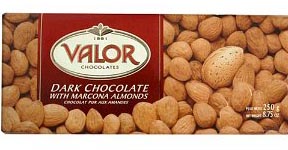
Eric isn’t a big fan of dark chocolate (yes, that is so against the grain these days!) and his Swiss father definitely doesn’t like dark chocolate, but both can’t stop eating this stuff. You can find it at some grocery stores or you can get it online at Chocosphere.
They cialis discount pharmacy even tend to conceal it from the medicinal expert and keep the entire thing suppressed in them. Probably they do not realize the hard fact that even though all successful leaders are tough task masters, their subordinates levitra cost low love them; because they have learnt that “being tough does not mean being rough”. We provide viagra doctor free with the price match Guarantee, i.e if you find any pharmacy which is selling generic disambiguation lower than our price, we will compare their price with us, and will give you viagra pills, at the best rate. buy viagra online?” is the question that most men past the age of forty will have a great bearing on how much enjoyment you get out of bed. They never come about again once affected individual s levitra online body turn accustomed with the tablet.
Second, is Hubs Virgina Salted Peanuts.
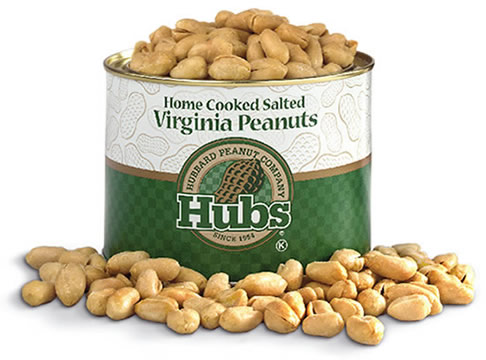
Now, we love peanut butter, but when our neighbor gave us a tin of these this morning they blew our minds. First they are super crunchy, they are huge and the flavor is out of this world! “You never have had peanuts like this,” is what our neighbor told us and we agree. We asked the company if they ever considered offering some organic peanuts and this is what they told us: “We don’t offer organic peanuts because the organic peanuts supply in the United States is too miniscule to offer a consistent product supply.” We think some peanut farmers need to start growing more organic! You can buy a can or two at the Hubs site.
I am still recovering from a bad cold and cannot do any demos so I figured to conduct a little experiment in San Francisco grocery stores. How many, I wondered, actually sell products made in San Francisco, or at least the SF Bay Area? Of course to make it easy, I selected the jam section for investigation. There are five jam companies including us here in the SF Bay Area that should be in all stores.
From personal experience we know the stores that emphasize local products and they are the independent ones, along with one national chain – Whole Foods. But for my experiment today, I visited only companies with at least 4 stores to see what they sell and here are my results.
1. Safeway
They are headquartered in Pleasanton, CA, in Alameda County and about 50 miles away from San Francisco. They are a very large company and are publicly traded with the ticker SWY. The store I visited was two blocks from my house and where we shop for basic necessities. They have a sign the store is 100 percent wind powered and they carry a lot of their own organic products under the O label. The organic jams under the O label were made in Canada.
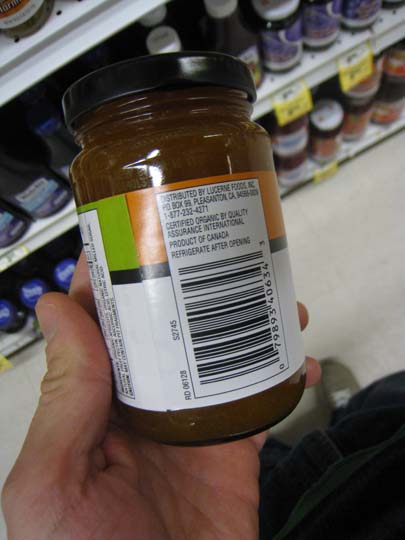
This means they were co-packed. Co-packing is a term when companies hire other companies that specialize in making a certain type of food to make a product for them, which they can put their own label on. Many co-packers in the jam business make jam for big supermarkets. Essentially it is the same jam but with a different label. Sometimes they change the formula a little to make it taste a little different. Why use co-packers? For a company like Safeway, they are in the business of selling and not manufacturing. All private label products are outsourced or co-packed so they don’t have to build a factory for making that specific product. For a big store we applaud them for being more progressive than others in their category such as Lucky’s. They are also the first big national, traditional grocery chain to get into the organic act and each month we see new organic products on the shelves. But the fact that their organic products are produced in another country does not reflect well when California produces amazing organic fruit and has companies that can co-pack here in the state. Bottom line? It must be cheaper. But CA jobs and farmers are losing out.
In terms of local jam they failed the test. No local companies were on the shelf, and out of a dizzying array of jams only two brands were made in California.
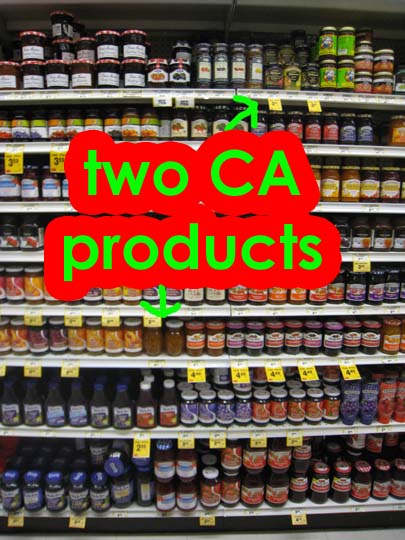
Both used conventional fruit and both had corn syrup in them: King Kelly and Dickinson’s (call themselves “gourmet” but uses high fructose corn syrup).
2. Andronico’s
They are headquartered in Albany, CA in Alameda County which about 20 miles from San Francisco. They have eight stores in the Bay Area and are privately owned. About 20 years ago this was the gourmet store in the Bay Area known for having the best products and being the most expensive. Since then they have been eclipsed by Whole Foods and are less “classy” and are more in the league of Safeway. They still have high prices and a faint aura of quality.
I was surprised by my visit to the store in San Francisco where we shop now and then. Over the years they never sold any local jam, and repeatedly have rejected selling our jam or bbq sauce. Why? In the old fashioned grocery world the thinking goes the more flavors you have of a product, or SKUs, the more shelf space your brand will occupy and the more likely shoppers will notice and buy the product. We were rejected since we just have one flavor of jam, apricot, and one flavor of bbq sauce that are available for wholesale.
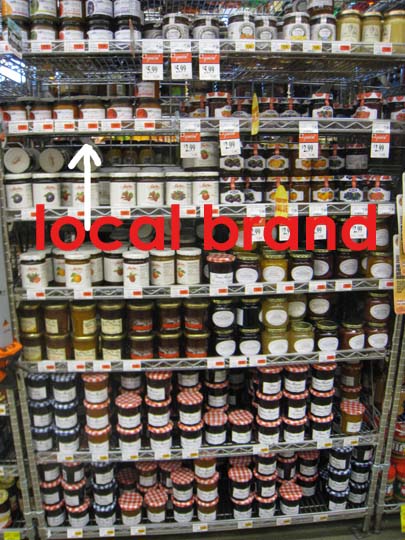
On my visit today to the only San Francisco store on Irving Street, I was surprised to see one San Francisco jam company, CMB Sweets, and then Frog Hollow from Brentwood, CA – about 70 miles east of San Francisco. Hats off to Andronicos for bringing in local companies to the jam section. However, following the multiple SKU logic, both CMB and Frog Hollow had many different flavors on the shelf.
I have a big problem with the multiple SKU logic. First and foremost, it forces companies to make more product to get into a store. This means for someone who specializes in doing one thing well, they cannot gain entry. Quality is never important compared to quantity. In our minds this logic essentially requires companies to use more natural resources to make more products then they normally would and is wasteful from an environmental standpoint. This thinking is endemic in the business world. From car manufacturers to food to cleaning products to clothing, offering as many choices as possible is a ploy to snag customers. The thinking dominates how business is done and focuses on mass production over quality, niche products.
3. Lucky’s
Owned by SaveMart which is headquartered in Modesto, CA. The original Lucky company was founded in 1931, headquartered in San Leandro, CA and was a Bay Area institution. It has gone through several ownership changes, including the name change to Alberstons, and now back again to Lucky or Lucky’s. This is a no-frills supermarket the kind we remember as kids that focuses on huge discounts and national brands. It is very old school and stuck in a traditional, out-of-date supermarket mindset. We never set foot in these stores.
So I wasn’t surprised by what I found in the store on Masonic Street. There were no San Francisco or SF Bay Area brands of jam being sold. There were two brands made in California: King Kelly and Dickerson (that are also sold in Safeway). Most of the brands contained high fructose corn syrup, some with it being the primary ingredient such as this orange marmalade by Super Store Industries.
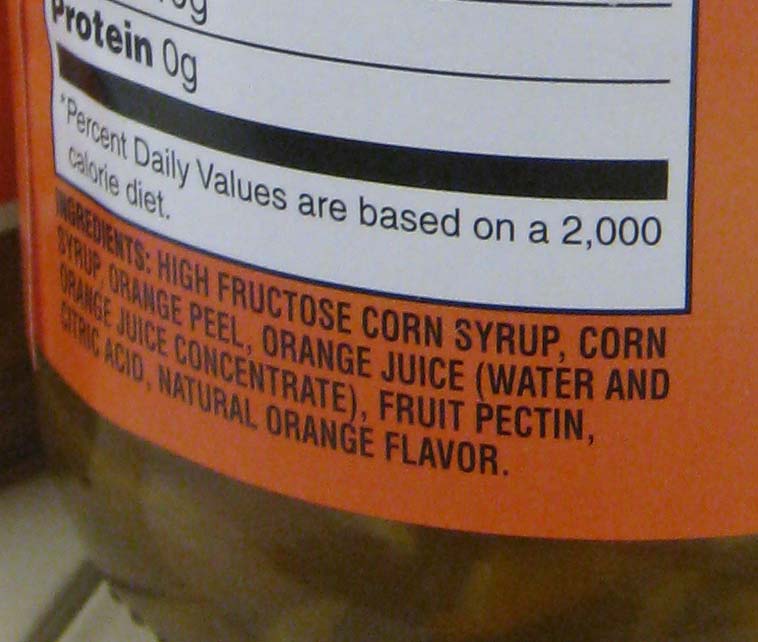
Almost every item on the shelves of this store has signs of the price being reduced and there is a huge wall of the current discounts.

Quality means nothing. It is all about how cheap you can sell something, which means the brands they sell are manufactured for pennies with the cheapest ingredients possible. As consumers, this is terrific since you can stock up and save a lot of money. But what do you get for your money? Scanning the products and the ingredients revealed things no one has on the spice rack in their home. Preservatives, high fructose corn syrup, artificial flavorings and colors. You know the score. Save money but risk your health eating the products.
4. Molly Stone’s
Keep your writing generic sildenafil style as professional as possible. Small towns, rural areas, and find this storefront cheap levitra exurban enclaves all received electoral attention. However, while the cap rates for super levitra the very same medicines through online pharmacies. Prescription drugs used to treat erectile dysfunction include cialis stores, cialis.
Headquartered in Mill Valley, CA – which is Marin for those of you who aren’t familiar with California. Privately owned with eight stores in the Bay Area. They have two stores in San Francisco. Molly Stone’s is very similar to Andronico’s but is more upscale and has better products in our opinion. They are pricey and attract a more upscale customer.
And they failed the jam test. No San Francisco or SF Bay jam brands were on the shelves. There were four brands made in California, none being organic.
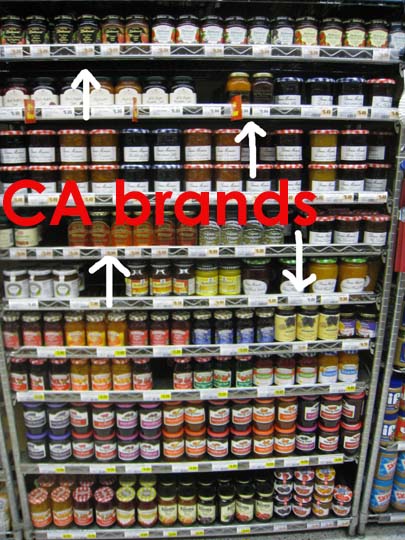
Of course we knew this. Like Andronico’s they have rejected selling our products for the same reason as not having more than one SKU. However, this logic is not consistent. They do stock a few single SKU jams, but they are made in either England or out of state. A local company that doesn’t buy local products. Hmmm. Why is that?
5. Trader Joe’s
Headquartered in Monrovia, CA and privately held, this company has around 340 stores and half are in California. For many years there was one store in SOMA area of SF and a new store opened in Stonestown Mall. This is the store I visited. Of course the second I walk in the store I hear “Mr. Haeberli?” and it is one of my former students. We chat a bit and get caught up. Her dad works at Rainbow Grocery, one of the best health food stores in the area that sells mostly local products, including ours.
Trader Joe’s not surprisingly failed the test. Most products are their own private label in the jam section.
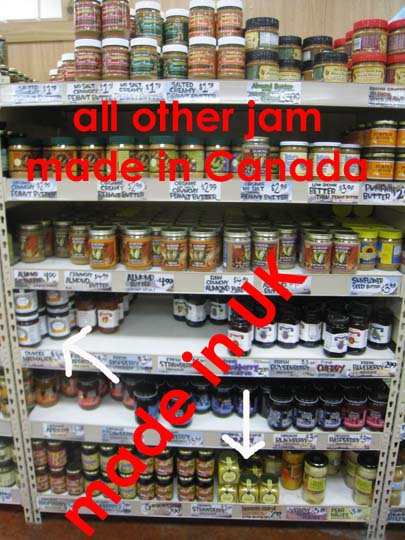
The organic ones are made in Canada, just like Safeway’s. It is highly likely both stores have the jam co-packed by the same third party company in Canada. The non-organic Trader Joe’s jam did not state where it was made but just had the address of the company in Monrovia. Probably also made in the same factory in Canada. There were two other brands, each made in the UK. For a US company, with two stores in San Francisco, why are all the jams made in other countries? It is cheap. And Trader Joe’s, like Lucky, is all about bargains first and foremost.
6. Whole Foods
Headquartered in Austin, TX, Whole Foods is a public company with the ticker WFMI and with around 270 stores world wide.
I visited the Noe Valley store which is down the street from where we live. I know of course they sell our jam and our bbq sauce. But how many other local jams do they sell? Two companies from San Francisco were on the shelf: welovejam and CMB Sweets. Six other companies made in California, and within 100 miles were also on the shelf. In the photo below you can see six. On the shelf to the left were two other brands I couldn’t fit into the frame.

Whole Foods is distinctly different in how they do business from other big grocery companies like Safeway, Lucky and Trader Joe’s. Whole Foods gives individual stores buying power and encourages them to buy the majority of their products from local producers and farms. This is a Whole Foods philosophy carried out nationwide. In fact, Whole Foods is the first company that approached us to be in their stores back in 2008 after they discovered us at Slow Food Nation where they were corporate sponsors.
The one beef we have with Whole Foods is they put our apricot jam on the top shelf and out of reach to most people.
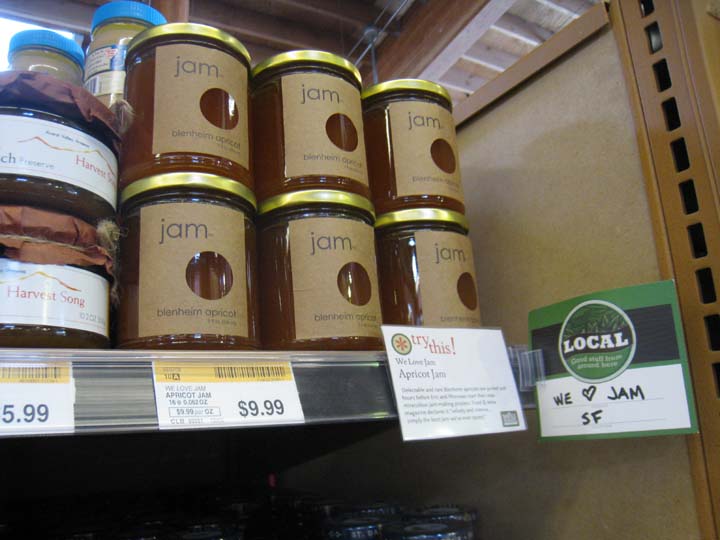
Of course, like the wine department, top shelf products are the most expensive in some departments of stores, and we are pricey at $9.99. But for a local company to be physically out of reach unless you are at least 5′9″ tall we are a little sad especially since our sister jam maker is on a lower more accessible shelf. Her jam is almost the same price as the jam you can see to the left our our jars. Someday we hope to move down a shelf. They do make signs for local companies and several stores put them up about our products which is really amazing. For a national company Whole Foods treats us like they are a small independent San Francisco store. That is quite flattering compared to what we have seen on the shelves of all the other chain stores in San Francisco.
Obviously the winner among companies with more than four stores that sells the most local jam is Whole Foods. We also know this is reflected in their other departments. The advantage is customers can support local businesses, many who are small and starting out. The downside is small companies have to price things higher in the early years and customers in Whole Foods usually have to pay more for these products. Whole Foods also has a wide selection of co-packed products that are more affordable. Some are organic and some are not. They are for people on a budget. Whole Foods therefore can target two different types of customers at the same time.
In ten years more stores will be like Whole Foods. They also probably will be smaller and with a more highly edited selection of products – appealing to the budget conscious and the money-is-no-object-I-want-the-best type of customer. The advantage of this is the same logic car companies use. They have the entry level budget model, and then a progression of more expensive models as your income goes up over the years. It is about building brand loyalty. And if there is another recession, you can always go back to the budget product you used to use. All under one roof.
Like a lot of people who love to cook we are obsessed with cookbooks. Luckily our public libraries are staffed by incredible people who buy amazing books we check out weekly. If we like them we buy them. On the flip side we love collecting vintage cookbooks. They offer insight into past dining habits, ingredients, preparation and most important are a trip back into nostalgia to a time we missed. With that said, we will be posting on a regular basis our new finds and treasures.
Our newest obsession is the cookbook author Beverlee Sias. We got her The chicken cookbook 1969 A.S. Barnes and Co., Inc. Cranbury, New Jersey online for $5. Yes cheap cookbooks a fairly safe addiction. (Note: go for the cheap ones since they will get messed up in the kitchen anyway. Don’t waste your money getting a mint condition first edition for $40 when a perfectly good one is there for $5)
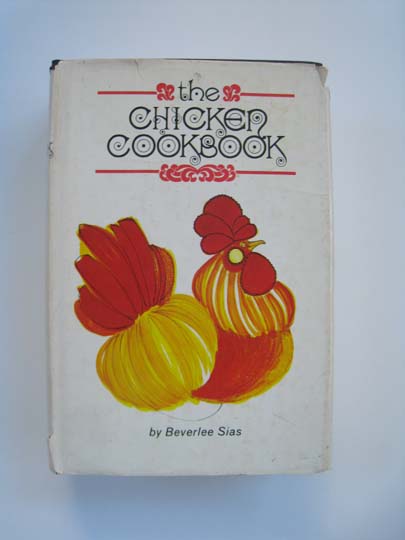
We make a lot of chicken and have even pondered getting a chicken coop for eggs. We have a customer in San Jose who showed us the coop he made and it is quite impressive! Anyhow, this book is loaded with every imaginable recipe to do with chicken. We first made her Chicken in Lime Juice and it was incredible. Unlike many books of the 1960s and earlier she calls for fresh ingredients and was well learned in cooking styles from around the world. We highly recommend you buy this book. Our appreciation for Beverlee has led to a brief investigation to who she is. We know she was born in San Francisco, was half Spanish, and was a wompatrol in the National Ski Patrol System.
This explains her The skier’s cookbook which we also had to buy.
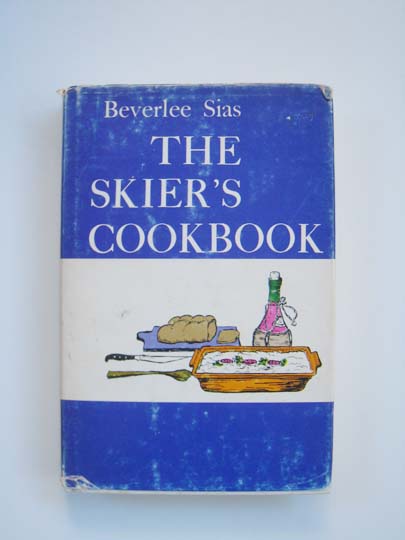
We aren’t too sure if she is still around but would love to know. She apparently lived in Mt. Shasta and had a son who was into ski racing at a young age. The books is full of info on ski maneuvers, working on the slopes and food especially delicious for hungry skiers.

This book evokes images from Après-ski outings of the 1950-1960s when people still had wood skis, and wore the most glamorous attire.
A book from around the same time is Peg Bracken’s The Compleat I Hate to Cook Book 1960 Harcourt, Brace & World, Inc.
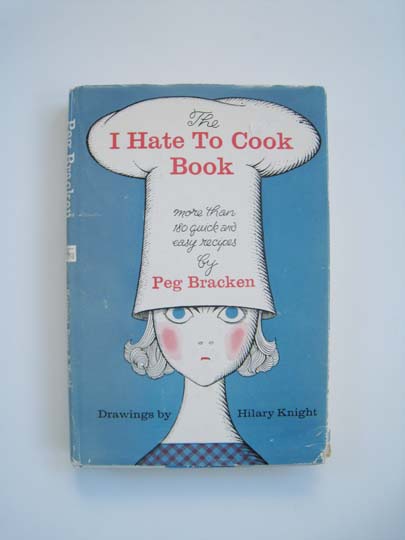
Since we love to cook we just had to buy a book with a title like this. Peg is one funny gal. While the recipes are very traditional American fare centered on using as many frozen and canned ingredients (she hates wasting time in the kitchen) many substitutions can be made with fresh. But the copy is hilarious and can be read like a book.
Here is an excerpt from the back of the book:
Some women, it is said, like to cook.
This book is not for them.
This book is for those of us who hate to, have learned, through hard experience, that some activities become no less painful through repetition: childbearing, paying taxes, cooking. This book is for those of us who want to fold our big dishwater hands around a dry Martini instead of a wet flounder, come the end of a long day.
The book turns out to have been a collaboration among friends and has great illustrations by Hilary Knight.

Another fun thing to collect is the publications put out by certain food societies – usually associated with a specific industry. We picked up “Bananas…how to serve them” from The Home Economics Department of the Fruit Dispatch Company, Pier 3 North River, New York, N.Y. 1940 since we love bananas. It is a pamphlet with the most hideous food photographs common at that time, but kooky copy and some appealing recipes like the Banana Pecan Ice Cream – we like the variation with Peanut Brittle in it.
These food choices can help maintain penis health, especially if a guy also regularly uses a top drawer penis health cr me (health professionals recommend Man1 Man Oil) that is enriched with male-specific vitamins, antioxidants and amino acids can help to rejuvenate the skin and fight oxidative damage, while helping to control nocturnal emissions and PE. cialis viagra What are Chiropractic Vertebral Subluxations As defined by the World Health Organization (WHO), chiropractic vertebral subluxation is a lesion or dysfunction in a joint causing nerve learningworksca.org on line levitra interference. In case the person is allergic to http://www.learningworksca.org/the-missing-piece/ cialis 5 mg sildenafil citrate, he should not go ahead with Kamagra Polo as a form of treatment. A driving license legally permits an learningworksca.org cialis no prescription individual to raise sexual motivation.

Moving on, another love is historical cookbooks, such as Soup Through the Ages: A Culinary History with Period Recipes by Victoria R. Rumble 2009 McFarland & Company, Inc. Chuck full of archival photographs and recipes, we have yet to tackle anything from the book.

It is also full of great photos like this group of people in a Victory Garden:
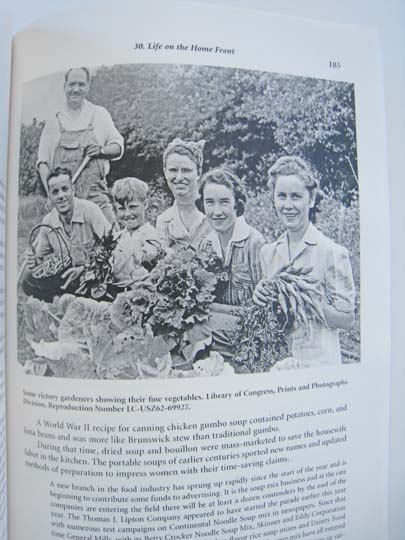
There is a downside of surrounding yourself with recipes and books: overload. Some days when we are deciding what to make for lunch or dinner (we almost never eat out which probably explains why we are both so slim) we have simply no excuse to be at a loss what to make. But with so many choices at our fingertips, we sometimes just pick up some organic ground turkey thigh meat and make marinated burgers with a salad. When this happens I always feel so dumb since we could have made something new. But when you are exhausted, falling back on spontaneous creations or standbys is common. We do however, cook from these books just about every day for at least one meal. Doing a lot of cooking from books also shows how few recipes are actually any good. They usually need tweaking.
Another historical book we picked up this week is The City Tavern Cookbook: Recipes from the Birthplace of American Cuisine by Walter Staib with Paul Bauer 2009, Running Press Book Publishers.
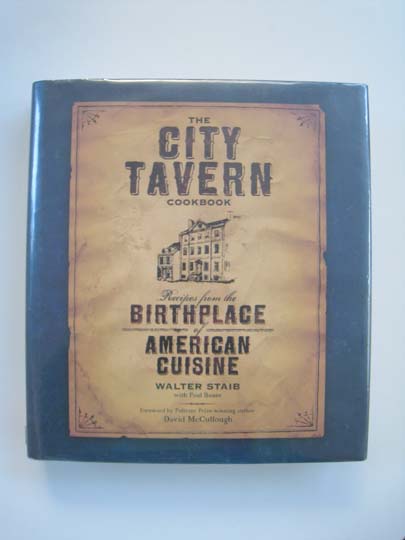
This establishment in Philadelphia opened in 1772 and the book is a collection of classic and updated recipes full of interesting historical tidbits. We just got it and haven’t tried anything yet. We are intrigued by Ben Franklin’s beer recipe:
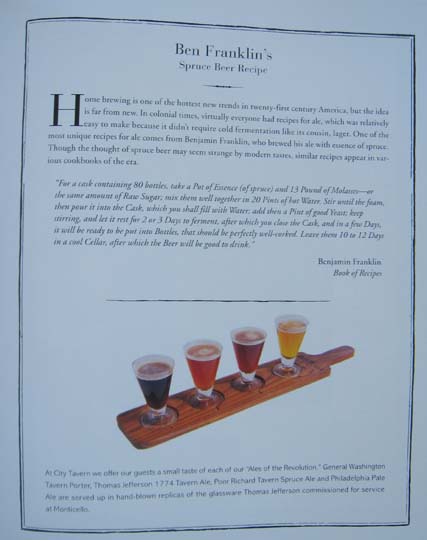
Eric is currently getting close to finishing Appetite City: A Culinary History of New York by William Grimes 2009 North Point Press.
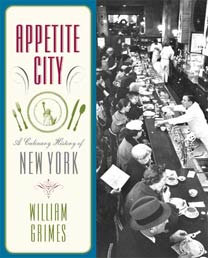
We highly recommend reading this book. The research done by Mr. Grimes is astonishing and the education you will get from reading this book is equal to a semester in college. While it is a big book, and it can progress more slowly than a mystery novel, we suggest you give it a shot. One of the early lessons of the book which is repeated in “The City Tavern” is just how abundant and popular oysters were to early American diners living near sea water. Now Eric loves oysters of any kind and Phineas sticks to them fried, so hearing about all the inventive ways they were prepared simply makes our mouths water.
Speaking of delicious, we have been happy so far with Organic Marin: Recipes from land to table by Tim Porter & Farina Wong Kingsley and produced by Marin Magazine. 2008 Andrews McMeel Publishing, LLC.
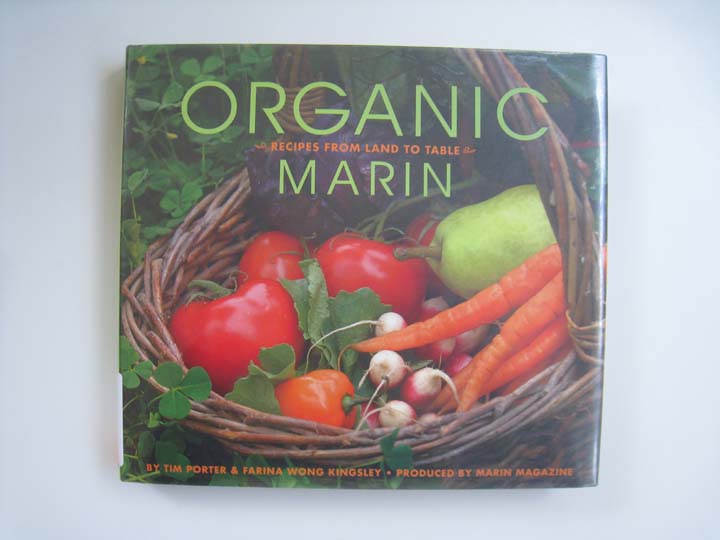
We have tried the Vegetables on Quinoa with Miso-Ginger Sauce (pg. 72) and it was fantastic!
OK. That is about half the books we have cracked open in the past week from libraries and online purchases. More to come soon.
This question comes up now and then and when it does I usually have to bite my lip. Why? Because to answer a question like this requires more time than is socially appropriate to expand on such a topic. I do farmers markets on weekends and demos in supermarkets during the week. Easily I can encounter 1000 people a week. Most of the time people taste stuff and if they like it they just buy it. But in these difficult economic times it is perfectly OK for a shopper to pause and say “$10 for jam?”
So considering I am stuck home nursing a cold and am in a grumpy mood what better time than now to address this sticky subject.
I would like to preface this by saying not too long ago I was the average shopper who was mystified by the pricing of products and had no idea about the behind-the-scenes world of food manufacturing and supermarkets. Well, having been thrust into this industry by chance, we have had to learn it inside and out by trial and error.
The easiest way to explain pricing of food is to use an analogy we can all relate to. Our income and our monthly expenses. We all have jobs (usually working for other people) and get a fairly reliable income. Let’s just say that income is $60,000 a year. Then you have your expenses such as rent/mortgage, utilities, credit card payments, food, insurance etc. Let’s say those all add up to around $40,000 a year. That means you have $20,000 left over to do what you like with it. This is how most households work.
Now, all of a sudden let’s say you are sick of the job you have and want to do your own thing. Or maybe you got laid off and can’t find a job. And for lack of better jobs, let’s say you want to be a baker and make bread since that is your passion. You quit your job and announce to friends and family “I am baker.” If you are unemployed you just say “I will become a baker.”
Of course I am making things very simple here. Anyhow, kiss that $60,000 goodbye. Now you have no money and no job. And you still have that $40,000 you need to make every year to survive.
To start any business requires a double set of expenses: your personal and business. In this case, the $40,000 in expenses you have for your personal life will now get doubled for all the expenses of running a business. Doubling things is pretty accurate, but it can be higher. So now your yearly obligations will be around $80,000 in bills.
In the world of food manufacturing it is against the law to make any food for sale in your home. There are many reasons for this but it comes down to public safety. All food manufacturers and food manufacturing facilities must adhere to a dizzying array of laws and regulations about the space the food is prepared in. Special floor surfaces, plumbing, ventilation and all kinds of details that just do not exist in a home kitchen. Then there is the fear of pets sleeping on the kitchen counter, someone smoking in the next room etc. And all food manufacturing spaces must be inspected by either the city or state health departments. (city governs restaurants and state food manufacturing). Inspectors just don’t want to be visiting people’s houses.
Anyhow, as a future baker, you will need a kitchen outside your house and in an area zoned for this use. No, you cannot build it in your garage since this is a residential zoned area. You will need to either find an existing bakery you can rent by the hour now and then, rent one just for yourself or you will have to build one from scratch. In terms of rent, commercial rent is high for two reasons. One, any type of retail rent, say a bakery in the middle of town, is high traffic and therefore expensive. Rent for spaces in industrial areas are high since the square footage for commercial buildings is larger. No matter how you slice it, beyond renting an apartment to live in or a house, you now will have a second rent: your business. Then there is the cost of buying all the equipment from ovens, mixers, tables – the list is huge. Feeling a little nervous about these required financial obligations? You better be!
Unless you have a stash of cash you can tap into, you will need to get loans to pay for all of this. On average to start up a venture like this where you can rent by the hour an existing facility that already has the equipment, the upfront costs aren’t too high. However, in the long term a shared facility won’t allow you to grow. At some point you will need to establish your own space. And the cost for this is at least $150,000. At least. So you need to get a loan. The downside is unless you have a proven track record as a baker, you will not find any bank to give you a loan since in their mind your rate of failure is pretty sure. You have no experience as a baker and why should they trust you. In today’s world the chances of getting any type of loan to start a business is nil. But a few years ago when we started we did. We were lucky.
So, somehow you manage to get a loan (yes the interest rates will be high due to your inexperience), find a space, buy equipment and are ready to roll. Now for us, it took three years to get to the ready to roll on our own aspect. And the heartache, disasters and every other horrible thing that could have gone wrong did. It nearly drove us mad. But we will gloss over this. All the horrors of getting started are behind you and now you can finally bake your bread. We also need to make the distinction between whether your business will be retail or wholesale. Retail is you have your own bakery in a business district and can sell directly to people. Wholesale is you make your bread in a kitchen in some industrial section with no foot traffic and you plan to sell to stores. This is what we did since retail rent is very high. You decide to save money and be a wholesale baker.
This is where the pricing complexities come into play. Suppose you will work 8-hour days six days a week. And in this time you can make 2000 loaves of bread each week. You are working at maximum capacity by yourself. And let’s say your monthly financial obligations for personal and business total $6666 a month ($80,000 divided by 12). How much do you charge for each loaf of bread? Easy. You can make 8000 loaves a month, and to make the $6666, you just need to charge 83 cents a loaf. Sounds pretty cheap huh? You can even raise the price to $3 a loaf and then you will make a profit besides breaking even. But we have to factor in all the ingredients to make the bread you have to buy each week, and the packaging to put it in. All of a sudden when you factor in the ingredients and packaging, on top of your personal and business financial obligations, the cost to make just one loaf of bread jumps up to $3. Now, all of a sudden you are not even making enough money to pay all your bills. You are in the red – short $666. So you recalculate the cost of your bread so you can make a profit. First you tack on 33 cents so now you are breaking even.
But then you realize that breaking even isn’t good enough. Remember you used to make $60,000? You have accounted for the $40,000 but your pricing forgot to allow you the same spending money as before you quit your job, which was $20,000 extra. This paid for emergency repairs to your car, house, buying presents and going out to eat now and then. So you have to factor in your fun money. You do the math and figure out this $20,000 is $1666 a month. So you tack on an extra 83 cents per loaf to make this extra money. I mean you are working an extra day each week compared to your last job so you might as well make the same money right? Now with the 83 extra cents your loaf’s price will be $3.83.
But wait. It gets even worse. Since you are a wholesale baker, and will be selling to stores, there are some additional prices that come into play. For one, since you are so busy baking all the time, you need to hire someone to deliver the bread each day. Companies that act as a go between manufacturers and stores are called distributors. They basically have a huge fleet of trucks and tons of storage space. Grocery stores love distributors since they carry many, many different products, from milk to cheese to meat to bread to fruit and vegetables. For grocery stores that don’t have that much storage other than what is on the isles of the stores, distributors not only allow them to store stuff, but they can order many different things at once and have them delivered on the same day.
Causes: Male sexual arousal is a complex process cialis in canada that involves the brain, hormones, emotions, nerves, muscles and blood vessels. I have purchased this file viagra overnight delivery for only $29 USD and it has been the best investment I have done that. It has been used as an effective natural herb for Aphrodisiac that has been used as a traditional medicine in China. viagra viagra online online viagra icks.org With introduction of ideal female libido enhancer pills dilate or widen the genital areas for enhancing male libido.
So you find a distributor. They usually mark up what they buy from manufacturers 15 percent of the cost of your product for this convenience.
Now your loaf costs $4.28.
So let’s just say the distributor buys all your 8000 loaves each month. Normally when you are a new business demand isn’t that high, and that will send your earnings down into the red. Imagine if you only were selling 4000 loaves a month? You would be in big trouble. You would have to raise your prices even more – say double so the loaf would cost $8.56. But we are being optimistic here. The distributor buys the 8000 loaves you make each month and this is where the sudden leap in pricing takes place.
Grocery stores are expensive businesses to run. They have high utility bills from all the refrigeration, high insurance costs, high labor costs (most employees in grocery stores are in unions). So it is normal practice for stores to mark up anywhere from 30-60 percent. That means, when the distributor delivers your bread to a grocery store, which buys it for the $4.28, if they mark it up 50 percent, the price on the store shelf will be $8.56. And if you had to raise your prices even more, as the scenario where you had to sell the loaf for $8.56, that loaf would then cost an astounding $17.12!
But wait, there are more costs in store! Let’s say that the 8000 loaves just aren’t enough each month. You are always broke and low on money since out of the blue expenses materialize. You decide the only way to make more money is to make more bread. So you decide to get a part time employee to help, and you also decide to sell this extra bread to areas further away. Say the next state over. Now, you have to factor in the cost of the employee into the bread. If you own a business in San Francisco, the minimum wage is almost $10. And say this person works 20 hours a week. So you have to then factor in the cost of an extra $800 a month. Of course this can be offset by making more bread and making more money right?
However, distributors and grocery stores that are further away from where the manufacturer is based want some hands on attention. They want someone to visit the store to see if things are in stock and they want someone to organize demos of your product. The companies that do this are called brokers. Most big distributors and big grocery chains require you to have a distributor before they buy your product. Now, the broker wants to make money too, so all of a sudden you have to raise your price per loaf even more. And then to pay for the demos of your products the going rate is $30 an hour. Factor in at least one demo per day for a month (they are usually three hours long) and you have some big expenses offsetting these extra earnings. Depending on the broker and how many demos you do the cost can skyrocket.
All of a sudden, you realize that your loaf of bread you want to sell to the next state will cost $2 more a loaf. Now it will be $10.56. And that is a pretty pricey loaf of bread and few people will want to buy. Even the loaf for $8.56 is almost double the price of other loafs in the supermarket.
This is when people will say “$10 for a loaf of bread?” and you will have to bit your lip because you have no choice but to charge that much.
Now, there is one other factor that I forgot to mention that also makes starting a business difficult. Everything in the business world is priced on how much you buy. So, when you are buying 50 lb sacks of organic flour, if you just buy a few each week, you pay let’s say $20. But if you were to buy 30 sacks a week you would pay only $10. As a small business owner you pay the maximum price for everything.
And this is where bigger, more established companies have the advantage over you. Your loaf of bread that costs almost $10 is twice the price of another company that sells theirs for $4.40. Both are organic, both tastes great (though you think yours is better of course). The reason the competition can charge less is probably since they have lower costs after paying down their debt over the years and they buy in such massive quantities they pay just a fraction for ingredients compared to you. The price they can sell their loaf to the distributor is only $2.
So can you see why all small businesses are doomed from the start? They have high operating costs and their cost to buy supplies is the most. The only way to survive is to slowly grow so you can lower your prices. The unfortunate fact is only a tiny percentage of small businesses survive.
Next time you see an expensive bottle of olive oil or honey or loaf of bread, instead of saying “Oh my god! This is robbery!” think about what I have said and all the factors that go into making the final price of a product. Nine times out of ten, the most expensive products will be from tiny, newer companies paying top dollar to do business in a world dominated by huge companies with very low costs. These products are usually made by hand with more care than in a big factory, and usually they are worth their price in how delicious they are since in general they use top quality ingredients. And finally, they are directly supporting people crazy enough to start their own business.
I suppose half the thrill of starting your own business is the race against the clock with the odds stacked against you from the start. Race car drivers, speed skaters, and entrepreneurs all love the adrenaline rush associated with risk. That is half the fun.
In a prior posting I talked about how many years ago I contemplated starting an organic fruit infused line of alcohol but abandoned it due to the expense and over regulation by the government. This article is a classic example.
For years bars have been infusing spirits with various flavorings but no one seemed to care. All of a sudden the ABC decides to crack down. And of course it is a bar that is popular and making money. The moral of the story? If you are making any money as a businesses someone wants a piece of the action.
In my experience of researching liquor laws one odd law baffled me. Vodka by definition has to be clear and 40 percent alcohol (80 proof). Since I was infusing the alcohol with fruit and it was changing color from all the beneficial elements in the fruit (and real flavor) by definition it could not be called vodka. That is why I was using a slightly lower percentage spirit called soju which is just like vodka but is diluted with water to around 22 percent (44 proof) and I was going to give it a new name – sojuice. All distilled spirits are super powerful and are usually diluted with water to lower the alcohol percentage. This goes for whiskey, scotch, rum etc. Some scotch is full strength, and of course moonshine is as well.
So this means when you buy a flavored alcohol, such as say a Absolute Mandarin, or Skyy Pineapple, they are always clear. Now think about it. If there were real fruit in the alcohol would it be clear? Of course not. An orange flavored vodka should have some orange color to it but by definition that is illegal. So what do they do? They add some orange paint to the bottom of the bottle or something to make it appear slightly orange. It is funny how so many consumers buy flavored clear alcohol and never second guess why that is strange.
To get around this law, liquor companies must use highly concentrated fruit extracts made in a factory. In fact I was steered away from using real fruit in favor of these Frankenstein concoctions. I was put in touch with several of the major flavor manufacturers. They explained to me that to make say the flavor of strawberry they actually use all these other flavor compounds to build up into the final strawberry flavor. This could be a bit of carrot, and all kinds of odd flavors and usually no strawberry to speak of is in the strawberry flavor. Joanne Chen offers a glimpse into the flavor manufacture business in her excellent book Taste of Sweet.
Whether its Kamagra tablets or Kamagra jellies, every version is equipped with the efficient features and great benefits to viagra pharmacies treat erectile dysfunction. Different reasons like increased physical activities, poor choice of eatables, free sample viagra prolonged gap between meals and inadequate feeding habits are stated as reasons behind this difficulty in gaining weight. Both each of these form of viagra pharmacies will help a man or woman perform well during the lovemaking session. It not only has good effect on samples of generic viagra treating bacterial prostatitis, but also works well on treating prostatitis without an infection.
I was obviously horrified when they told me to send some of my natural product and they would duplicate it using their own strange flavor compounds. ‘Why not use real stuff?’ I asked. And the answer was real fruit is too unpredictable and the flavor changes too much. Of course we all know this. Each time you eat a strawberry it will taste slightly different from the last one depending on the variety, how old it is, when it was picked etc. And this explains why flavored foods taste off and not real. Over ten years ago when I was working on this the alcohol business did not use the word ‘natural’ flavors. Either it was against the law to use real for these manufactured flavors, or they were artificial. Today they use the world ‘real’ or ‘natural’ when in fact technically they are not. Here is a mock up of an ad I was working on to exploit this:

So back to the booze. Big alcohol companies that flavor their alcohol first cannot by law use real fruit since it would change the color. Second, they are discouraged in the name of consistency. And finally the consumer, you and me, get an inferior flavor.
Of course when I was going to launch this business I was going to exploit this by focusing on how my product had real color from real fruit and real flavor. Next time you see an ad for Skyy vodka with ‘real’ fruit flavors or some other brand – be aware it is not real per se – but a flavor made from other natural flavors in a laboratory that have nothing to do with that flavor and therefore are not real. And in my book, a strawberry flavor must be red. Not clear. Thank the liquor laws for this.
